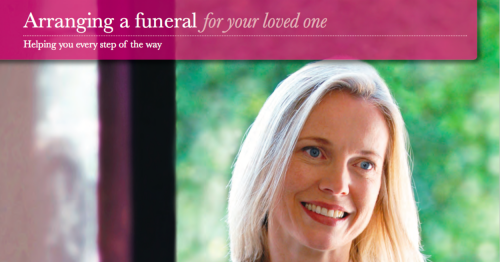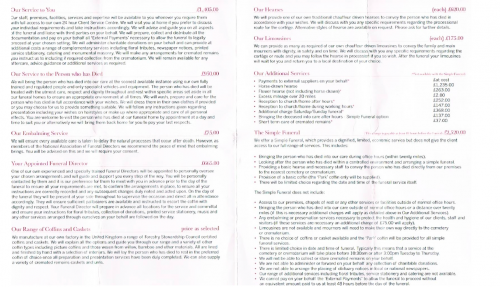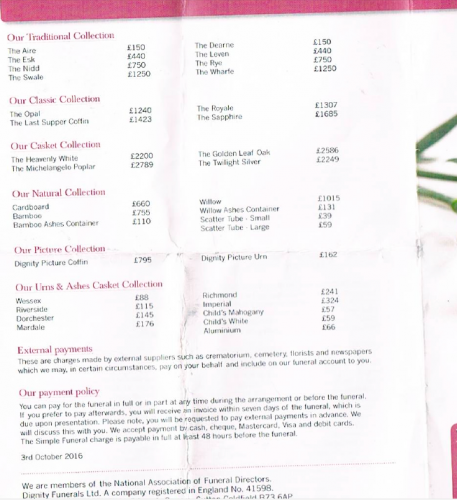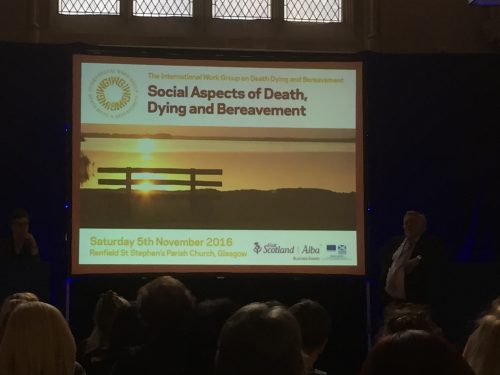Posted by Mark Sharron
This is the fourth part in the “SEO for Funeral Directors” series. Previous posts can be found here:
Quick Introduction
I am the founder/director of Sussex SEO Ltd. I have been building websites for clients and optimising them to be found in Google and other search engines since 2006.
This post will focus on “local SEO” and should build nicely on my previous entries. It’s always a little difficult to know where to begin so I’ll start with a quick explanation of Google’s first page of results for and build on each concepts/techniques as the article progresses.
If you have any questions, please feel free to ask in the comments section below.
What is meant by local SEO
Discounting PPC you have two opportunities to rank for any location based keyword e.g. Brighton Funerals / Brighton Funeral Director.
- The local 3 pack, commonly referred to as Google maps.
- The traditional 10 organic spots on the home page.
Both the local pack and organic results share a number of common ranking factors; however there are some unique differences required to secure a position in the coveted local pack.
Creating a local signal for your website can be distilled into three core areas:
Key Concepts
- Google Maps/My Business
- Location of Your Business
- Google My Business/Google Plus
- NAP Consistency
- Onsite SEO
- Business Name / Domain
- Entities vs Keywords
- Entity Relationships / Knowedge Graph / Entity Databases (less scary than its sounds)
- Understanding Semantic Search
- Maps
- Youtube Part 1
- Linking Out
- Structured Data (this one is a bit scary)
- Offiste SEO
- Links
- Citations
- Youtube Part 2
Assuming I haven’t lost 90% of the GFG’s readers already, to get things started I’ll explain each of the key concepts, what they are and how they fit into the larger puzzle.
Google Maps / My Business:
Location of Your Business
The first thing to check is the physical location of your business. Google your keyword, in this case Funeral Directors + Location and look at where the map pins for where your competitors appear.
Google’s objective is to return local results. If your physical business address is located outside the area you will not be able to get a placement in the local pack. The same rule holds true if your business is on the perifphory of a locale. The further you are away from Google’s map centrum the harder it is to rank (not impossible, just harder).
Google My Business
Google My Business (formerly Google Plus, Google Local, Google Places) is the lynchpin that holds everything together.
A Google business listing is an online profile, it is free to sign up and requires you enter your business name, a link to your website, phone number, opening times, logo, images, email address and business classification.
The key is to fill out your profile 100%. Until recently it was possible to upload a description however ability has been rescinded giving increased weight to your business name, website URL and website copy.
Google will insist on verifying your business listing with a postcard. These usually take 1-2 weeks to arrive and will contain a PIN number that must be submitted before your listing will go live.
Ensuring your business listing / associated Google plus page are active / updated regularly, joining local / related communities and acquiring high scoring reviews are also essential ranking ingredients.
NAP Consistency
NAP is short for “Name, Address, Phone Number.” Google checks to ensure these details are aligned between your Google Plus page and your website. There are a few important factors to consider.
- Ensure your NAP data matches Google Maps.
- Correct: Brighton, The City of Brighton and Hove
- Incorrect: Brighton, East Sussex
- Place your NAP in your website’s footer.
- Ensure your NAP data in your website matches your Google Business listing 100%.
Onsite SEO:
Business Name / Domain:
SEO is a labelling exercise. Its easier to rank if your business name / domain is a partial match or exact match. At the very least include “Funerals” or “Funeral Director” in your domain. It will make your life a LOT easier.
That’s the east stuff out of the way…
Entities vs Keywords
This next section will explore onsite SEO starting with the use of language on your website. To give you a quick grounding in local SEO it helps to understand the difference between an entity and a keyword.
A keyword is something a user types into the search engine to find something. E.g. Brighton Funeral Director or Sussex Funeral Director
An entity is person, a place an object or a thing.
For example:
- Brighton (entity) a place
- Sussex (entity) a place
- Funeral (entity) a thing/ceremony
- Funeral director (entity) a thing/profession
Entities are usually associated/related to other entities. If we review the “onsite SEO” article I posted last year, you can create a ranking signal using placement of keyword throughout your website.
Avoid Over Optimisation
Placement of too many of the same keyword within page content (more than 4% density) may result into Google penalising your site for over optimisation.
One of the work arounds is use of related language within the text on your site e.g. coffin, death, cremation, burial to build relevance around the funerary theme.
This technique can be used to boost your website’s “local” relevance by understanding which entities are associated with your “business area” and working these into the fabric of your website.
The easiest way to examine these is via Google’s knowledge graph. I’ll use Brighton as the example. Click to make it bigger.
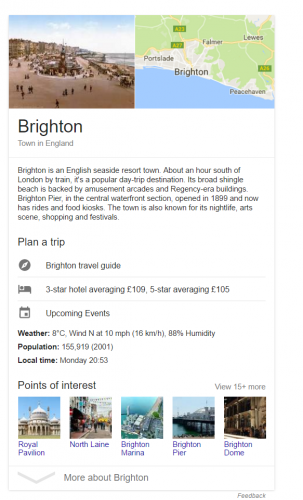
The important points to pick up on are the entities (locations) that fall within the greater Brighton area, these include Portslade, Falmer, Peacehaven. If you zoom in on the map you will also find Rottingdean, Whitehawk, Hove, Saltdean, Roedean and a lot more.
In addition, you will notice points of interest located within Brighton and Hove (these are also entities).
Drill down deeper and you will find references to people (check Wikipedia).
Semantic Search
It is these associations of entities and related language that forms the basis of semantic search which is an un-necessarily complicated way of explaining that the search engine is able to understand that concepts are related to one another other. To cite the above example if I reference “Rottingdean, Whitehawk and Fatboy Slim” the search engine will understand I’m talking about Brighton and Hove.
Local Signals:
To further boost the relevance of your site you can add “local signals.” Placement of related entities within the text goes a long way but there’s more to it.
Google Maps:
Add an embedded Google map with your business listing and add a link back to your Google maps/business listing.
YouTube:
Commission a video with a “local” focus (more on this later). Embed it on your website.
Embed Reviews:
Embed reviews from Google into your site. This can be done with Google’s API. You’ll need to ask your web developer to do this.
Link Out:
Reference points of interest / official local government offices (entities) within you text and link to them (make sure Google links to them from its knowledge graph).
Structured Data:
Structured data is a means of adding an invisible layer of code to a website to a enhance ranking signal or control how a website is displayed within Google’s index.
There are multiple forms of structured data, the one most commonly used is referenced at http://schema.org/.
The idea behind structured data is to allow a web master to clarify content to the search engine by marking it up with schema.
https://schema.org/LocalBusiness provides a number of actionable examples e.g.
Without Schema:
<h1>Sussex Funerals Ltd</h1>
Independent Brighton funeral directors for caring, compassion & choice. Providing excellent 24 hour personal service.
185 Portland Road
Hove, The City of Brighton and Hove
Phone: 01273 736469
With Schema:
- <div itemscope itemtype=“http://schema.org/LocalBusiness”>
- <h1><span itemprop=“name”> Sussex Funerals Ltd</span></h1>
- <span itemprop=“description Independent Brighton funeral directors for caring, compassion & choice. Providing excellent 24 hour personal service.</span>
- <div itemprop=“address” itemscope itemtype=“http://schema.org/PostalAddress”>
- <span itemprop=“streetAddress”>185 Portland Road</span>
- <span itemprop=“addressLocality”> Hove</span>,
- <span itemprop=“addressRegion”> The City of Brighton and Hove</span></div>
- Phone: <span itemprop=“telephone”>01273 736469</span></div>
This is just scratching the surface with schema. You can mark up almost every entity imaginable and create associations using the “sameAs” attribute. Of all the steps I have listed so far this is without a doubt the least accessible to most and I would recommend speaking with your web developer a preferred digital marketing professional to help implement this step.
Offsite SEO:
Links
Link building is an important part of any SEO campaign; in fact, it is essential to ranking well on
Google other search engines. Google places a heavy emphasis on quality and quantity of inbound links as a measurement of how authoritative/trusted a site is for its subject matter.
Counting how many 3rd party websites to your website is a means for Google to the reputation/trust/authority if your website.
The more competitive a key phrase being targeted; the more links will be needed to achieve a desired search engine rank for a given keyword.
Relevant links will rank your site. Irrelevant links will either be less effective or cause Google to perceive your site as being less relevant. To give you some examples:
- Funeral focused site e.g. this one = relevant(good link).
- Brighton / Sussex focused site = relevant to area (good).
- Site about Death = indirectly relevant (still good).
- Site about piano’s = irrelevant (bad)
As mentioned above, links are essential to ranking your website.
Citations
A citation is an implied link and affects your websites prominence in Google’s local pack.
A citation is simply your business name, address and phone number (NAP) placed on a 3rd party site such as a business directory. The trick is to ensure the NAP matches that placed on your Google Business profile and website.
In addition is important to ensure data such as business opening times are aligned.
YouTube:
Google owns YouTube. It therefore comes as no surprised that Youtube video’s can help influence local SEO prominence. Creating a video which references your business details and focuses on one of your primary keywords creates a relevant link, citation and rich media which once embedded into a web page will drive your site’s exposure. This article provides a comprehensive guide.
Conclusion:
Configuring a website to be found within Google for a desirable keyword (SEO) is at its heart an exercise of two halves:
- A labelling exercise (keyword research: understanding what users search for and labelling your content accordingly)
- Matching and exceeding your competition (quality / quantity of relevant content & links)
Any questions ???

